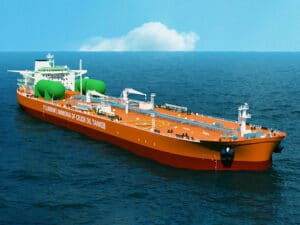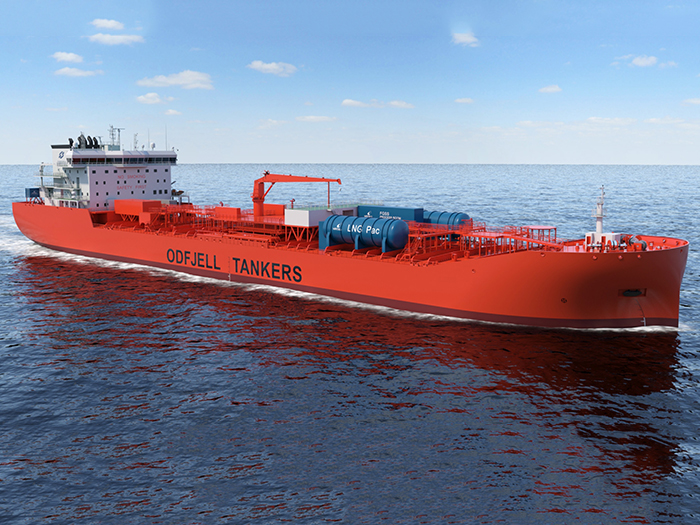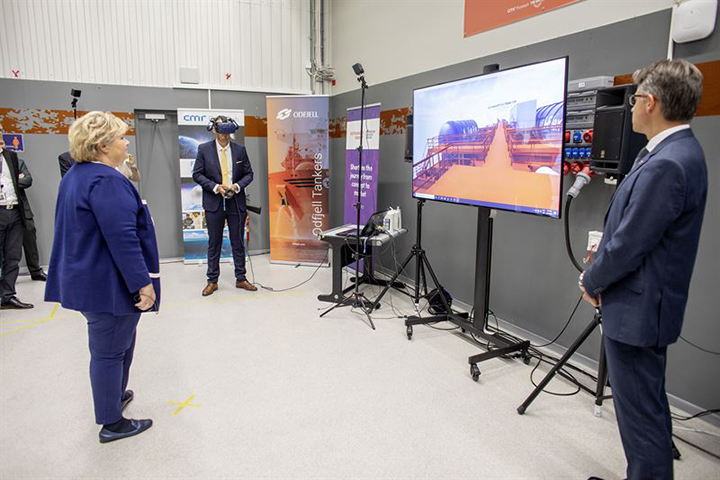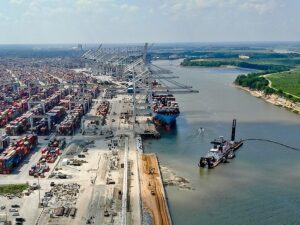
Odfjell to pilot new flexible fuel cell technology
Written by Nick Blenkey
Illustration of the fuel cell solution mounted on board an Odfjell ship. [Photo: Odfjell]
Norwegian Prime Minister Erna Solberg yesterday got a first-hand briefing on new and flexible fuel cell technology said to reduce emissions from shipping by 40% to 100%. Prime Minister Solberg was attending a ceremony to celebrate an expansion of Norway’s Sustainable Energy Catapult Center, where a 1.2 MW fuel cell using the technology will be tested before installation on a chemical tanker. .
The new technology is suitable for many different types of fuel, including green ammonia and LNG, giving ship operators the flexibility to choose fuels according to availability.
The main participants in the project are the Odfjell Group, which will trial the technology on one of its newest chemical tankers, fuel cell specialist Prototech, Wärtsilä and Lundin Energy Norway.
“Our tests show a CO2 reduction of as much as 40-45% when using LNG, compared to current solutions. Increased efficiency and reduced fuel consumption also provide significant cost savings, and the ship will be able to sail significantly longer on the same amount of energy. The system will also be ready to operate completely emission-free from the locations where, for instance, ammonia is available for bunkering,” says Bernt Skeie, CEO of Prototech. “The technology also enables direct capture of CO2, which will be yet another alternative for emission-free operation when logistics for CO2 management become available.”
The project aims to develop a technology that can provide emission-free operation over long distances. Battery solutions are currently not suitable for operating the deep-sea, long haul segment of the world fleet.
In addition to high energy efficiency, the fuel flexibility of the technology promises substantial emission reductions from day one, using currently available LNG infrastructure, while also preparing for emission-free operation as the infrastructure for sustainable fuels is developed.
“Ships are to be operated for 20-30 years, and we need flexible solutions that can meet future emission requirements. We do not have time to wait, we have to think about zero emissions now,” says Erik Hjortland, VP Technology at Odfjell SE. “The fuel cell project is one of the paths we are pursuing. We focus on machinery rather than focusing on one single type of fuel. Fuel cell technology gives us flexibility that ensures environmentally efficient operation regardless of fuel changes that may occur in the years ahead.”
“Greater efficiency and increased sustainability are at the core of Wärtsilä’s Smart Marine Ecosystem vision. We see the combustion engine remaining as the stalwart of shipping, because it has the flexibility to operate on future renewable fuels as and when they become compliant, market-ready and available. However, we are keen to support all efforts and innovations aimed at reducing the carbon footprint of shipping, and we see this fuel cell project as being an important contribution to this effort,” says Ingve Sørfonn, Technology Manager at Wärtsilä Marine Power.
“The development of this fuel cell is an example of how forward-looking shipping companies and our unique maritime expertise have the prerequisites to drive new solutions through a broad collaboration within the maritime cluster,” says Harald Solberg, CEO of the Norwegian Shipowners’ Association. “In the long run, scaling up such solutions will be of great importance in achieving our climate goals, they will have business value, and they can create new jobs in Norway. Norwegian shipping has set ambitious climate goals. This type of projects is very important for us to be able to develop solutions that quickly reduce emissions.”





